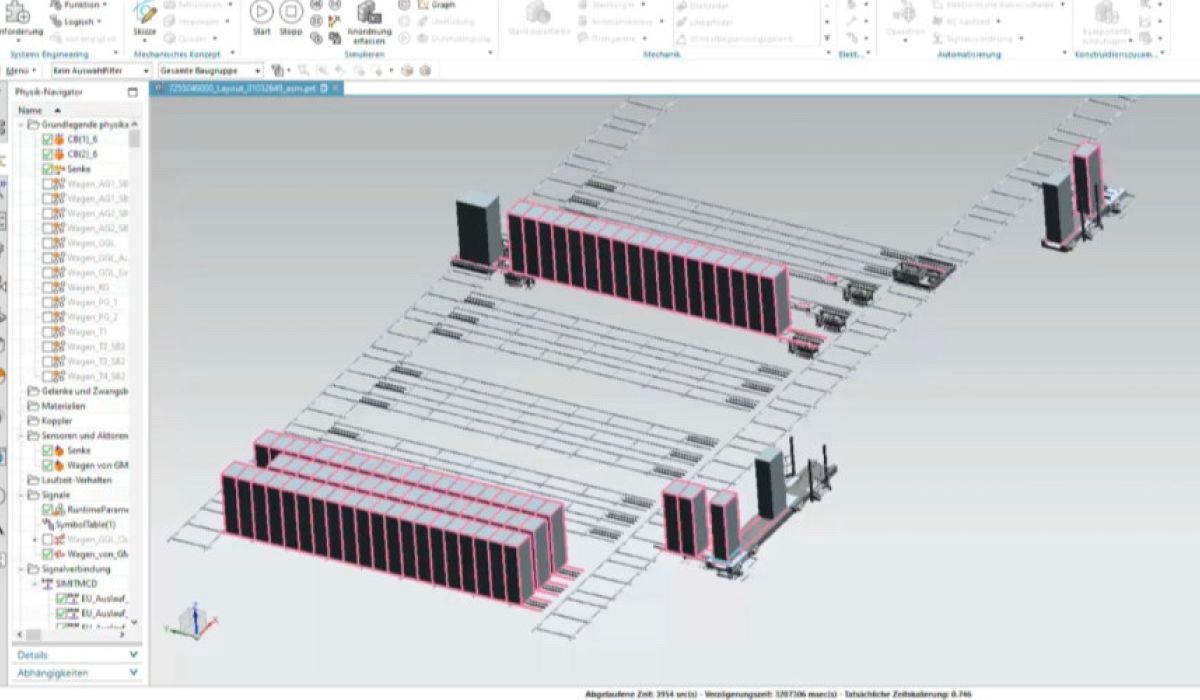As part of a Master's thesis and in cooperation with Siemens, a so-called virtual commissioning was carried out at Münstermann for the first time during a project. The aim was to test new methods for further developments in machine and plant construction. The complexity of the plants we develop is increasing and the proportion of automation and the use of sensors for process monitoring is growing.
What is a Virtual Commissioning?
In principle, virtual commissioning is the virtualisation of a production plant in order to prepare or simulate the subsequent real commissioning. The potential benefits of virtualisation can be a shortening of the real commissioning, better software quality or troubleshooting in advance of a real commissioning.
However, the creation of the digital twin (the virtualisation of the real system with a software model) involves a non-negligible amount of work. The digital twin simulates data that would come from the sensors in the real plant (e.g. the position of a transfer table). Real or virtual PLCs can be integrated into a model. The digital twin is thus the link between the virtual and real worlds. The basis for virtualisation is a 3D model of the plant and the Mechatronic Concept Designer (MCD), which can be used to kinematicise existing mechatronic systems.
Other software from Siemens that was used is
- Totally Integrated Automation Portal (TIA Portal)
- SIMATIC S7-PLCSIM Advanced
- SIMATIC SIMIT Simulation Platform (Kurz: SIMIT)
The project also tested the use of non-Siemens controls (although not very extensively), for example a Rockwell control. The first results show that the simulation works in principle.
Simplification is essential.
As with all simulations, the simulation model is crucial for success. If the model is too detailed, the simulation time may be long. If the model is too simple, the results may not be really meaningful. Common sense and process know-how help in creating the virtual model.
The choice of tests or simulations needed should be well prepared in advance. Often, empirical values about critical processes or procedures in projects are available. Focusing on potential problem areas is more effective than a detailed simulation of the entire plant. Testing individual components reduces complexity.
When selecting tests, it is important to check for correct functioning or possible other errors. For us as a special plant manufacturer, this results in additional work in the long run, since each project, each plant is developed differently, quasi as a unique specimen. Accordingly, a new model must be developed for each system.
Specific application
The application is a conveying project typical for Münstermann. The production plant consists of dryers (not supplied by Münstermann) which are loaded and unloaded with dryer cars. Münstermann supplied the complete conveyor technology including transfer cars, chain pushers, special corner transfers and the control system.
The dry material is automatically loaded and unloaded into the dryers with the help of transfer cars. Dryer or kiln transfers with a high degree of automation are the norm in many industrial sectors. Functions such as batch tracking or the use of a wide variety of sensors, e.g. for the design of safety technology, are standard.
Implementation of the Virtual Commissioning
For the virtual commissioning, various functions were modulated and simulated in a modular way, e.g.:
- the transfer cars and wire rope hoists supplied by us
- the dryer infeed and outfeed
- and part of the intralogistics
In comparison with the real plant, various problems did not occur during the simulation. For example, there were problems with the hardware used (e.g. frequency converter and light barriers). The mechanical interface to an existing machine led to an error. Another mechanical error was not noticed in the simulation because a sensor for a corner converter was constructively placed in the wrong place. The simulation of the transfer table, on the other hand, worked very well.
Short video of a simulation
Below is a short simulation sequence shown in a video. The speed is faster than in the real layout. After about 40 seconds, one can observe that a dryer car falls over at the end of the track. Here it has been simulated that a limit switch has failed and no redundant second limit switch is installed.
Conclusion
In practice, it has been shown that errors can be eliminated in advance with a virtual commissioning. Constructive mechanical faults are detected well. However, a fault is only detected if it has also been designed. If a fault occurs during assembly, it cannot of course be detected in advance. Problems that always occur on a construction site cannot be simulated either (late deliveries, delays, etc.).
There is additional work involved in creating the simulation model, and the model may well contain errors that are not present in the real plant. Because of the simulation speed, the simulation model should be kept as small as possible and, if necessary, functions should only be roughly simulated or the plant should be broken down into smaller parts. Certainly, the time needed to create the simulation model will also be shorter with more experience.
On the plus side, a number of advantages can be identified:
- Often part of the automation programme is written during the (real) commissioning on site. It is conceivable that with the help of a preceding simulation, larger parts of the programme can be completed in advance and thus shorten the real commissioning.
- Testing of borderline situations: Borderline situations that are not tested in reality due to dangers for people and material can be simulated safely in the simulation.
- For more complex projects, a simulation can provide a better understanding and overview of the plant, especially for customers during meetings.
- A virtual commissioning can be used for training employees to present the sequential and logical process of a plant to the customer.

